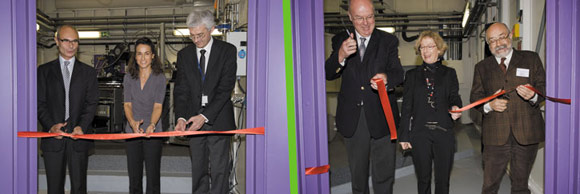- Home
- Users & Science
- Scientific Documentation
- ESRF Highlights
- ESRF Highlights 2011
- Electronic structure and magnetism
Electronic structure and magnetism
At the time of writing this introduction the major construction works for the ESRF upgrade are in full swing. The electrons are no longer circulating in the ring and the laboratory has become a construction site with the scientific visitors replaced by workers with hard hats. The creation of new experimental facilities and long beamlines will be possible in 2013 when the buildings are handed over to the facility. By then we will be well into phase I of the upgrade. These new facilities will be crucial to the long term success of the ESRF allowing us to carry out experiments not possible today.
As the upgrade is reaching its peak activity, we are seeing the first fruits of the programme in terms of new beamlines appearing on the floor. The XAFS beamline (BM29) has been refurbished and moved to BM23 to be next to its sister beamline ID24. We envisage new highlights coming from the better performance of the new beamline and continuing the impressive history of BM29. More importantly, ID24 has been fully upgraded with two branches and has started commissioning. It was inaugurated at the November Scientific Advisory Committee (SAC) meeting as the first Upgrade beamline. The new facility provides optimised X-rays for small and large spot activities, improved stability, and a 1000-fold increase in time resolution for single shot studies.
Within the Electronic Structure and Magnetism group the next step in upgrading the beamlines will come with the closure of the ID08 soft X-ray beamline in the second half of 2013 and the construction of the new upgrade beamline on ID32. The new beamline will extend to 120 m making full use of the new building. Its scientific programme will centre on the use of two techniques: very high energy resolution soft X-ray resonant inelastic X-ray scattering (RIXS) and state-of-the art soft X-ray dichroism.
 |
|
Ribbons were cut during the inauguration ceremony of ID24 to mark the opening of two new beamline branches. Left: High-pressure/extreme conditions branch. From left to right: Francesco Sette, ESRF Director General, Sakura Pascarelli, Scientist in charge of ID24, Harald Reichert, ESRF Research Director. Right: Chemistry branch. From left to right: Michel van der Rest, vice-chairman ESRF Council, Geneviève Fioraso, Députée de l’Isère et Adjointe au Maire chargée de l’Economie, l’Emploi, l’Université, la Recherche, Rafael Abela, Chairman ESRF SAC. |
However, recent budget cuts have impacted on the group beamlines and the magnetic scattering beamline ID20 has closed during the past year: this was not before producing some very interesting results on multiferroics as can been seen in these Highlights.
The challenge now is to produce new exciting proposals for a much anticipated phase II of the ESRF upgrade which will be one of the main objectives for the coming year. If a phase II were funded then it would also be an opportunity for new upgrade beamlines. These could be, for instance, in the areas covered until recently by the magnetic scattering beamline and the hard X-ray circular polarisation beamline (ID12) which have not been part of the phase I upgrade, or they could be something totally new.
The upgrade will allow us to improve our experimental facilities and offer better possibilities to our user community. This will be true for the group beamlines already being upgraded and we hope for the other beamlines in phase II. Despite the difficulties, we have to think to the future and, once they have finished the concrete work, to move forward with a scientific programme taking full advantage of the new facilities in order to strengthen our activities in the areas of magnetism and electronic structure research.
N.B. Brookes



